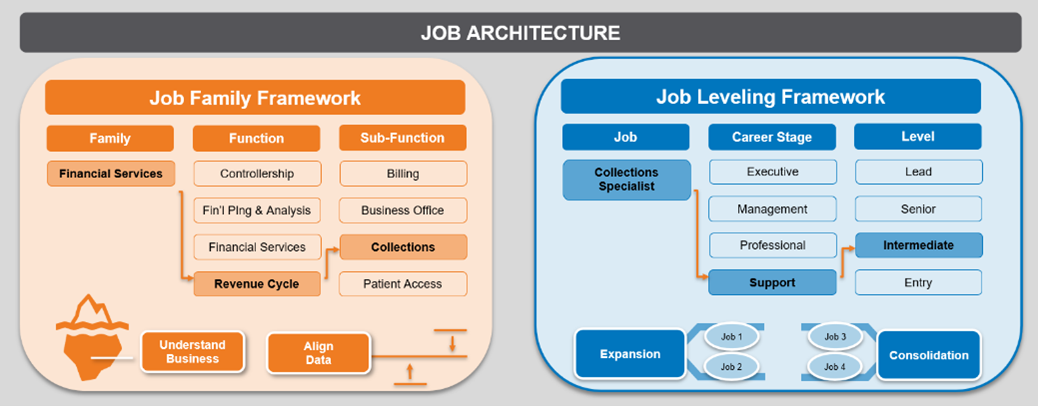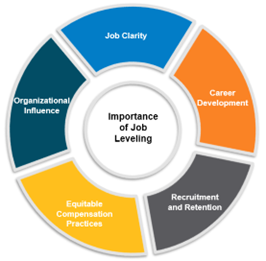Take Your Organization’s Career Architecture to the Next Level
Support effective workforce planning and organizational success with job leveling.
Misty Gaeke, Principal – SullivanCotter
Liz Snyder, Principal – SullivanCotter
Hospitals and health systems nationwide are working tirelessly with the same goal in mind: to deliver best-in-class patient care. Health care organizations strive to hire and retain the best and brightest clinicians, support staff, and leadership. Simply put – your people are your greatest asset. That’s why organizations continually seek ways to optimize their talent management processes, enhance employee engagement, and support recruitment and retention.
One way to help optimize talent management is to use a consistent and well-developed job leveling process. This is a critical component of an organization’s career framework. It can be deployed alongside a complete job architecture design or developed on its own as a step in the overall journey. In today’s competitive landscape, organizations must understand the significance of job leveling and how it can serve as a cornerstone for effective workforce planning and organizational success.

What is Job Leveling?
Job leveling helps to determine the relative career stage, level, and title of a job using a structured approach to define and apply critical factors of a role’s responsibilities. At its core, job leveling is the process of categorizing an organization’s positions based on the complexity, responsibility, and skills required for each role. In health care, roles can vary significantly from entry-level support positions (e.g., medical assistants) to specialized leadership roles (e.g., service line leaders). Job leveling provides a consistent and effective approach to understanding each position and establishing a structured hierarchy.
When determining the relative level of a job, we recommend that organizations start by asking the following questions:
- What level does the job report to?
- What is the impact and scope of the work performed?
- How complex and varied are the issues faced?
- What is the level of autonomy? Does this role operate relatively independently or require greater supervision?
- Does the role oversee a function or department? Does it include management responsibilities? If so, what is the total span of control?
- What qualifications, skills, years of experience, education, certification, or licensure is required or preferred?
Why Does Job Leveling Matter?
A consistent job leveling structure clarifies career progression and helps streamline an organization’s hierarchy and decision-making process. It also supports talent retention and career development by forming the basis for compensation benchmarking, salary structure design, and the overall development of a competitive total rewards package.
- Job Clarity: When employees can see how their position fits within the job leveling framework, they can better understand the role’s expectations and tailor their duties to meet or exceed those expectations. This reduces ambiguity and helps employees focus on maintaining performance and achieving both individual and organizational objectives.
- Career Development: A job leveling framework helps define career paths and offers a transparent roadmap for advancing within an organization. The career development path has evolved in health care over the years. Employees often look for opportunities to grow not only up the traditional career ladder but across, gaining skills in adjacent or complementary areas. When clearly communicated and designed as part of an overall job architecture, job leveling frameworks enable employees to understand the progression pathways linked to their roles and recognize growth opportunities across the organization by understanding where there are potential similarities in job levels and responsibilities. This helps keep them engaged in their current positions and motivates them to explore opportunities to move up or across the organization.

- Recruitment and Retention: A well-defined job leveling framework enhances an organization’s ability to attract top talent. When job levels are undefined or applied inconsistently across an organization, employees can become frustrated if they think their role should be linked to a different level. It can also be challenging to attract the right type of people to a role that is not correctly defined or leveled. Clear job level definitions, titles, and career progression pathways show potential candidates that an organization values structure and development. Further, existing employees are more likely to stay with a company that is objective and consistent in their job titling and offers transparent career growth opportunities, which helps reduce turnover and the associated costs of hiring and training new staff.
- Equitable Compensation Practices: Job leveling enables organizations to better manage compensation benchmarking and establish equitable pay structures by ensuring that comparable roles are compensated similarly. This helps to avoid pay disparities and foster a culture of fairness and transparency. When employees feel they are being compensated fairly, their job satisfaction and loyalty increase.
- Organizational Influence: Job leveling helps align employees’ and the organization’s expectations of relative influence and responsibility. Clearly defining job levels and associated responsibilities ensures that each position understands and is able to contribute effectively to an organization’s decision-making and governance processes as well as the overall strategy and goals.
Implementing an Effective Job Leveling Framework
Consider these five simple guidelines if your organization is looking to implement a new job architecture or job leveling framework:
1. Understand Your Organization’s Unique Needs
Consider the specific requirements and characteristics of your organization. Job leveling should align with your organization’s design and structure, which includes how the company is organized, its goals, and the roles that exist within it. Understanding these unique aspects helps ensure the job leveling framework effectively supports your organization’s objectives and functions.
2. Develop a Job Leveling Framework
Create a structured framework that clearly defines different job levels based on criteria that your organization identifies as essential to defining and delineating job level distinctions. It is also important to align the levels and criteria to the organization’s compensation philosophy and grading structure to understand the extent of the impact the job levels may have on your existing pay programs.
3. Define Job Leveling Criteria
Establish clear criteria for categorizing jobs into career stages and levels based on accountability, complexity, skills, and experience. For leadership roles, additional attributes such as budget responsibility, organization level, span of control, and levels of oversight should also be defined.
4. Seek Buy-In and Approval from Leaders
Make sure to establish and communicate with a steering committee and/or a cross-functional work group throughout the process to gather input on the design and implications of the framework. It is important to consider all areas and all potential impacts in the design phase before finalizing your structure and rolling it out to managers and employees.
5. Communicate to Employees
Share the job leveling framework with employees to ensure they understand the criteria for advancement and how their roles fit into the broader organizational structure. Being transparent can also help to build trust and engagement across the organization.
Conclusion
Ultimately, the primary goal of any health care organization is to provide high-quality patient care. A well-structured job leveling framework ensures that the right people are in the right roles with the necessary skills to perform their duties effectively. As a critical component of an organization’s overall job architecture framework, robust job leveling practices are essential to effectively managing your employee workforce. Providing employees with greater clarity and consistency regarding job roles, expectations, and pathways for advancement is key. It helps to align employee aspirations with the organization while fostering a culture of growth and development and enables more equitable compensation practices – a key driver in improving talent acquisition, retention, and employee engagement.